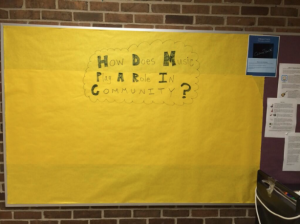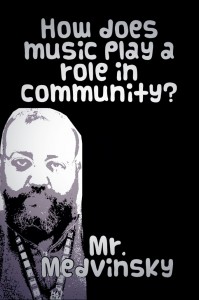I received an email from a friend after my first Musician’s Workshop post. He sent me a quote that framed his thinking, and now mine, for how teacher feedback plays a role in the workshop model.
Lucy Calkins (1994) shares “[o]ur decisions must be guided by “what might help this writer” rather than “what might help this writing.” If the piece of writing gets better but the writer has learned nothing that will help him or her another day on another piece, then the conference was a waste of everyones time. It may even have done more harm than good, for such conferences teach students not to trust their own reactions” (p. 228)
Conferences
Conferences in Musician’s Workshop have many similarities to other workshop models. When I am conferencing with a learner/musician, or a small group of musicians creating together, this is the process:
- Ask the learner/musician or group of musicians to perform what they have so far. (Assessing the learner/musician’s performance as they play or sing)
- Ask the the learner(s) what their contribution is as a musician to the piece.
- Ask the learner/musicians where they feel they need support.
- Specifically scaffold one musical dimension (element) at a time, either something the learner/musician contributed, or what you had heard during the initial performance.
- Scaffold their playing if needed.
- Ask them to describe the ways in which they will use the strategy they just practiced.
The conferences usually take anywhere from 8-10 min depending on how much support is needed or the size of the group. You may only get to 2 or 3 groups in one class period (I see each class for 30 min.) and that is okay. The other learner/musicians need that time to practice independently.
Ask the learner/musician or group of musicians to perform what they have so far. (Assessing the musician’s performance as they play or sing)
As you listen to the piece being performed, try to identify where the learner/musicians are in their process. At what stage are they in composing their piece? For example, if the they are creating a binary piece, are they creating the A, or B, or transitioning between both?
To identify the area of struggle, you may also ask an open ended question. For example, you may ask “How will the listener know when the music has moved to the next section?” The learner/musicians will explain their thinking and may uncover a misconception. If they answer something way off, you may ask a follow up question such as “What makes you say that?” This clarifying question will help guide you in helping the learner/musician move closer toward understanding. Their performance coupled with the learner/musician’s answers and explinations will help you assess the depth of their understanding.
Specifically scaffold one musical dimension (element) at a time, either something the learner/musician contributed, or something you had heard during the initial performance.
To continue with the binary example, If the learner/musician is having difficulty maintaining a steady beat and also composing contrasting sections, choose one and focus on that. I would start with the steady beat first to solidify the groups simultaneity and come back for the contrasting section. Keeping a steady beat and the group together is more important than composing a contrasting section.
Ask them to describe the ways in which they will use the strategy they just practiced.
This is their time to synthesize their plan. Understanding how to implement a new strategy into their process is an important step. I will confer with them about the strategy and through our dialogue, create a plan. The learner/musician makes a plan and begins to put they plan into action. These are intrinsic goals that the learner/musician decides on to make them a better musician, which in turn supports their contribution to the music.
I ask the learner/musicians to reflect upon their experience using tablets and student response systems. This allows me to gather their thinking in one place. The next time they visit my classroom, I have their individual goals on my iPad to better support our conferences.
There have been many teachers and administrators writing about the need to establish relationships before learning may occur. Musician’s Workshop enables relationships to form through individual conferences, open ended questions, valuing the learner/musician’s prior experiences, and focusing on the process. This is a growth mindset model that is differentiated for each musician.
Are you facilitating a Musician’s Workshop in your classroom, yet?
Calkins, L. (1994). The art of teaching writing. Portsmouth, NH: Heinemann.





